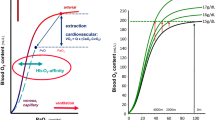Abstract
The effect of a ascent to moderate altitude (2,300 m) and altitude training on the O2-transport properties of Hb and their possible consequences on tissue oxygenation during exercise were studied on six control and six training subjects. A rapid increase in P-50 values (+2.4 mm Hg, 0.32 kPa) was measured within one day after ascent. At the end of the stay at altitude (13th day) P-50 values were higher in subjects performing training than in controls. At altitude a slow but constant increase in 2,3-DPG, pyruvate kinase activity and reticulocyte count was found, which was more pronounced in training subjects as compared to controls. Ascent to altitude resulted in a decreased maximal performance capacity (−9%), but both groups recovered during the stay. In training subjects maximal exercise performance was increased after descent. Exercise at altitude was performed at a lower heart rate (controls: −10/min; training: −18/min) and at a lower lactate concentration (−4 mmol/l). These data indicate a positive effect of adaptation to altitude on exercise performance. Training itself shifts the ODC to the right and adds this effect to the effects of passive altitude adaptation on the O2-binding properties of hemoglobin.
Similar content being viewed by others
References
Alexander JK, Hartley, LH, Modelski M, Grover RF (1967) Reduction of stroke volume during exercise in man following ascent to 3,100 m altitude. J Appl Physiol 23:849–858
Aste-Salazar H, Hurtado A (1944) The affinity of hemoglobin for oxygen at sea level and at high altitudes. Am J Physiol 142:733–743
Astrup P, Engel K, Severinghaus JW (1956) The influence of temperature and pH on the dissociation curve of oxyhemoglobin of human blood. Scand J Clin Lab Invest 17:515–523
Banister EW, Woo W (1978) Effects of simulated altitude training on aerobic and anaerobic power. Eur J Appl Physiol 38:55–69
Beutler E (1975) Red cell metabolism: a manual of biochemical methods. Grune and Stratton, New York
Böning D, Schweigart U Tibes U, Hemmer B (1975) Influences of exercise and endurance training on the oxygen dissociation curve of blood under in vivo and in vitro conditions. Eur J Appl Physiol 34:1–10
Böning D, Trost F, Braumann KM, Bitter K, Bender H, Mühlen A, Schweigart U (1981) Physiologische Wirkungen eines 22öchigen Skiurlaubes in 2000–3000 m Höhe (Blutgastransport, Blutzusammensetzung, Hormone, körperliche Leistungsfähigkeit). In: Deetjen P, Humpeler E (eds) Medizinische Aspekte der Höhe. Thieme, Stuttgart, pp 29–37
Cunningham DA, Magel JR (1970) The effect of moderate altitude on post-exercise blood lactate. Int Z Angew Physiol 29:94–100
Dill DB, Graybiel A, Hurtado A, Taquini AC (1940) Der Gasaustausch in der Lunge im Alter. Z Alternsforschung 2:20–33
Eaton JW, Brewer GJ, Grover RF (1969) Role of red cell 2,3-diphosphoglycerate in the adaptation of man to altitude. J Lab Clin Med 73:603–609
Eaton JW, Skelton TD, Berger E (1974) Survival at extreme altitude: protective effect of increased hemoglobin-oxygen affinity. Science 183:743–744
Edwards HT (1936) Lactic acid in rest and work at high altitude. Am J Physiol 116:367–375
Edwards MJ, Rigas DA (1967) Electrolyte labile increase of oxygen affinity during in vivo aging of hemoglobin. J Clin Invest 46:1579–1588
Grover RF, Lufschanowsky R, Alexander JK (1976) Alterations in the coronary circulation of man following ascent to 3,100 m altitude. J Appl Physiol 41:832–838
Haidas S, Labie D, Kaplan JC (1971) 2,3-Diphosphoglycerate content and oxygen affinity as a function of red cell age in normal individuals. Blood 38:463–467
Humpeler E (1980) Anpassungsmechanismen im Sauerstofftransport des Blutes an physiologische und pathologische Veränderungen. Wien Klin Wochenschr 93:123 (Suppl)
Humpler E, Inama K, Deetjen P (1979) Improvement of tissue oxygenation during a 20-days stay at moderate altitude in connection with mild exercise. Klin Wochenschr 57:267–272
Humpler E, Inama K, Jungmann H (1980) Die Sauerstoffaffinität des Hämoglobins 3 Studen nach passivem Höhenweschsel von 400 auf 1800 m. Wien Klin 92:326–329
Lenfant C Torrance J, English E, Finch CA, Reynafarje C, Ramos J, Faura J (1968) Effect of altitude on oxygen binding by hemoglobin and on organic phosphate levels. J Clin Invest 47:2652–2656
Mairbäurl H, Humpeler E, Schwaberger G, Pessenhofer H (1983) Training-dependent changes of red cell density and erythrocytic oxygen transport. J Appl Physiol 55:1403–1407
Neville JR (1977) Erythrocyte age and shape of the oxygen dissociation curve (Abstract). Proc Int Congr Physiol Sci 27th Paris 23:548
Rand PW, Norton JN, Barker N, Lovell M (1973) Influence of athletic training on the hemoglobin-oxygen affinity. Am J Physiol 224:1334–1337
Remes K, Vuopio P, Härkönen M (1979) Effect of long-term training and acute physical exercise on red cell 2,3-diphosphoglycerate. Eur J Appl Physiol 42:199–207
Rörth M, Nygaard SF, Parving HH (1972) Effect of exposure to simulated high altitude on human red cell phosphates and oxygen affinity of hemoglobin. Influence of exercise. Scand J Clin Lab Invest 29:329–333
Sachs L (1968) Statistische Auswertungsmethoden, 1st edn. Springer, Berlin Heidelberg New York
Shappell SD, Murray JA, Bellingham AJ, Woodson RD, Detter JC, Lenfant C (1971) Adaptation to exercise: role of hemoglobin affinity for oxygen and 2,3-diphosphoglycerate. J Appl Physiol 30:827–832
Turek Z, Kreuzer F, Hoofd LJC (1973) Advantage or disadvantage of a decrease of blood oxygen affinity for tissue oxygen supply at hypoxia. Pflügers Arch 342:185–197
Winslow RM, Samaja M, West JB (1984) Red cell function at extreme altitude on Mount Everest. J Appl Physiol 56: 109–116
Yoshimura H, Inove T, Yamada T, Shiraki K (1980) Anemia during hard physical training (sports anemia) and its causal mechanism with special reference to protein nutrition. World Rev Nutr Diet 35:1–86
Author information
Authors and Affiliations
Rights and permissions
About this article
Cite this article
Mairbäurl, H., Schobersberger, W., Humpeler, E. et al. Beneficial effects of exercising at moderate altitude on red cell oxygen transport and on exercise performance. Pflugers Arch. 406, 594–599 (1986). https://doi.org/10.1007/BF00584026
Received:
Accepted:
Issue Date:
DOI: https://doi.org/10.1007/BF00584026




